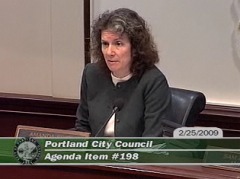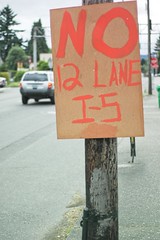
before voting “no” on the proposal
last night.
(Image: City of Portland)
At their meeting last night, Portland’s City Council gave Mayor Sam Adams authorization to vote in favor of a 12-lane Columbia River Crossing (CRC) bridge.
But, according to Adams’ office, the vote does not mean the Mayor (and council) have signed off on a 12-lane bridge.
The proposal on the table was meant to move the deadlock in CRC negotiations over the number of lanes the bridge will eventually have. In order for the process to move forward, the design and engineering timeline requires that key conceptual decisions (like the number of lanes) are made.
Adams created his proposal in partnership with Vancouver Mayor Royce Pollard. Prior to the meeting, Mayor Adams and Vancouver Mayor Royce Pollard penned a joint op-ed in The Oregonian about it. In, The way forward across the river, they wrote:
“A new Interstate 5 bridge across the Columbia River is about more than the number of lanes or new transit service or tolls. It’s also an opportunity to show ourselves and the nation a smarter way forward.”
Adams knows that many of his constituents would be extremely disappointed if he gave outright support to a 12-lane bridge so it’s no surprise he opened the editorial by de-emphasizing the importance of the lane quantity decision.
Listening to him introduce the proposal at last night’s hearing (thanks to the video stream on the city’s website), Adams explained this decision not as open invitation to build a 12-lane mega-highway (that many critics fear), but as an innovative step forward in the city’s ability to manage roadways. Here’s more from Adams (emphasis mine):
“We are known in this region as being innovators when it comes to certain aspects of transportation. Clearly we are innovators when it comes to transit, when it comes to pedestrian mobility systems, when it comes to bike mobility systems. We actively plan and manage those transportation modes but when it comes to vehicular roadway management we are, in my opinion, in the dark ages. We tend to build a freeway, build a road — especially if its outside the grid and especially if it is a freeway — we just sort of walk away and leave it to function however it’s going to function.
I have long advocated this region to take a more active role in managing our transportation systems.”
According to the proposal that council supported last night, that “active role” will come in the form of a Columbia Crossing Mobility Council. That group, whose formation must still be approved by the CRC’s Project Sponsors Council, would be tasked with “developing performance based management recommendations for the Columbia River Crossing project.”
This morning I asked Adams’ senior transportation policy advisor Catherine Ciarlo for clarification on just what exactly happened last night. Here’s how our conversation went (this is a paraphrase from my recollection and notes):
What does this all mean? Did Adams and city council just approve a 12-lane CRC bridge?
“What it [the vote] does is sets up Commissioner Adams to cast a vote at the Project Sponsors Council to approve building to accommodate 12 lanes. So, in that sense, yes it does…but if and only if there is a commitment around the table [at the Sponsors Council] to create a Columbia Crossing Mobility Council.”
What if the Sponsors Council says no to the Mobility Council?
“If there’s no agreement on this Mobility Council, there’s no agreement to build to accomodate 12 lanes.”
OK, so it’s clear to me that this Mobility Council and its ability to make decisions about the management of the bridge was Adams’ take in the give-and-take compromise between he and Mayor Pollard. But, what exactly will the Mobility Council do?
“By creating this council we have a way for the local jurisdictions, including Portland, to participate in the ongoing management of the project. For instance, this Mobility Council may decide — in the work it does between now and 2018 [when the project is slated to be built] — that 12 lanes doesn’t make sense (the striping of the bridge is the last thing that will happen), that it would be too many and that it would result in induced demand and that it doesn’t meet a certain level of greenhouse gas emissions.
So, it’s possible it would be built to accomodate 12 lanes but it would actually open at 10 lanes…we haven’t said yes to striping 12 lanes.
The beauty of it is that these decisions will be made not just by the DOTs (state departments of transportation) but by all of the agencies that have a dog in the fight…”
Can you define what you mean by “management”?
“This is about management to achieve goals that you set. We’ve been using the thermostat analogy. You use a thermostat to regulate air flow to decide how warm you want your room — this management will serve as a thermostat for the bridge. Do we have too much congestion? If so, you use the tools you have to fix it [which could be tolls, a different mix of transit and HOV lanes, etc…]”
The vote on the number of lanes, and on whether or not to approve this Columbia Crossing Mobility Council will be decided on March 6th by the Project Sponsors Council. The important thing to remember is that if the Mobility Council is not approved, Adams will likely vote against 12 lanes.
If Adams votes no on 12 lanes on March 6th, in many respects the lane decision would go “back to the drawing board” according to Ciarlo. Without support from a key player like the City of Portland, our federal delegation is not likely to support funding for such an expensive project.
As you can see, this is a very high-stakes dance. With his green light to move forward on a 12-lane bridge, Adams has given up a lot. But in return, he is saying that the bridge needs to be managed in a way that makes sense and he hopes his Mobility Council will be the innovative tool to move the region out of the, as he puts it, “vehicular roadway management dark ages”.
Of course, not everyone sees this in the same, positive light as Adams’ office.
On February 11th, Nigel Jacquiss, the Willamette Week reporter who broke the Adams-Breedlove story, wondered if Mayor Adams’ “political weakness” would lead to a 12-lane bridge. And, judging from comments left here on BikePortland late last night and on other local sites, many of Adams’ constituents are very disappointed about the direction this is headed.
Update: One commenter below is not convinced:
“This is total BS, and not even a convincing spin. If you believe these lies from Sam, clearly you will believe anything he says.
This should serve as Exhibit A in support of the proposition that Adams has been so seriously weakened by his self-induced scandal that he can no longer effectively represent the progressive Portlanders who elected him.”
Commissioner Amanda Fritz, the sole dissenter last night, did nothing to soften her criticisms of the proposal. She said she is “profoundly disappointed that this authorizes a 12 lane bridge.” Fritz raised health, cost and community livability concerns. She also pointed out how council’s tone on this project has changed over time:
“I’m concerned… that the resolution passed last July called for the smallest possible bridge, when it now turns out that the smallest possible bridge requires the most possible lanes.”
Michelle Poyourow of the BTA says she is still “frustrated that there are no quantified outcomes for this bridge.” While she is glad Adams is trying to establish the Mobility Council to determine (and then manage) those outcomes, she adds that, “but they will be managing that in the context of a 12-lane bridge.”
“I just don’t think it’s responsible,” she continued, “to decide on the size of the bridge without first deciding on the management strategy and goals.”
Is Adams’ proposal the light at the end of the tunnel? Or, regardless of the intricate politics and wonky policy-speak going on here, is this a sign of a weakened and compromised Mayor Adams who was once seen as someone who would stand up against the CRC? Are we headed for mega-highway oblivion with Mayor Adams at the wheel? Will his management idea pan out and ultimately bring us a sensible, multi-modal bridge? Is it even possible for a 12-lane-sized bridge to be sensible no matter how it’s striped or how many buses and bikes it carries?
A lot of questions and only time will tell.
— Video of last night’s meeting can be watched on the City of Portland website. The CRC proposal (agenda item #198) begins at the 78:20 mark.


